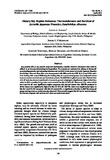Dietary soy peptide enhances thermotolerance and survival of juvenile japanese flounder, Paralichthys olivaceus
Share
Abstract
Soy peptide (SP), a soy protein enzymatic hydrolysate, contains bioactive substances that could be utilized as an immune-stimulating feed ingredient. The experiment evaluated the efficacy of dietary SP on promoting growth, and enhancing tolerance and survival to heat stress in juvenile Japanese flounder, Paralichthys olivaceus. Four diets were incorporated with different levels of SP (0, 2, 5, and 10%) and a 6-wk feeding trial ensued. Following the feeding trial, the experimental groups were subjected to heat stress to measure survival rate and heat shock protein 70s (HSP70s) in gill, liver, and skin. Fish fed diets with SP inclusion showed considerable decrease in percent weight gain. Significantly higher lethal time values to 50% mortality (LT50) value were recorded for fish fed 10% SP. Moreover, LT50 values of fish fed 2 and 5% SP were significantly higher compared with fish fed control diet. HSP70s produced in all the tissues were significantly highest in fish fed 10% SP. HSP70s values were significantly higher in fish fed 2 and 5% SP compared with fish fed control diet. A significant reduction in HSP70s among all groups during recovery period was also observed. These results suggest that SP can be used to enhance the immune response and survival of P. olivaceus under heat stress.
Suggested Citation
Ragaza, J. A., Mamauag, R. E., Yokoyama, S., Ishikawa, M., & Koshio, S. (2015). Dietary soy peptide enhances thermotolerance and survival of juvenile japanese flounder, Paralichthys olivaceus. Journal of the World Aquaculture Society , 46(2), 129-138. https://doi.org/10.1111/jwas.12183
Subject
Collections
- AQD Journal Articles [1249]

